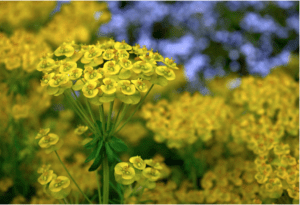
As usual, Pam was full of hints and ideas, many of which are repeated here. Like most experienced horticulturalists, her primary advice was to look after the composition of the soil, which in Glen Park is most often heavy clay, or sometimes sand.
It took me years to realize I should be gardening the dirt more than the plants!
One begins with the slow but important process of adding organic matter or compost to the soil – this will help it retain moisture. It’s possible to purchase bags of compost or make your own. Commercial compost often includes material such as rice hulls to lighten heavy clay soil. It may be necessary to lightly dig in the new material if your soil is compacted. The aim is a kind of loamy, dark, friable soil alive with earthworms, beetles, fungi, bacteria, and many tiny, microscopic creatures. Then you can follow up by adding thin layers of organic mulch to further help retain moisture and slow weed growth.
And – stop with the chemicals already! The use of chemical herbicides, pesticides, fungicides, and fertilizers will eventually kill your soil and its water retaining capabilities, not to mention the adverse impact on beneficial insects, bees and birds.
Again, look after your soil. Then think about changing your watering techniques. Using a drip irrigation system benefits the garden by providing small amounts of water regularly so the soil does not dry out. In addition, Glen Park Garden Club members have successfully installed systems to recycle household wastewater from washing machines. And if you are letting your garden dry out more, you may need to resort to the technique of watering for short periods with breaks in between to allow water to soak into dry soil. Lastly, consider reducing the number of containers, and don’t start that new lawn or vegetable garden just yet!
Remember most new plants require regular deep watering to establish those long, strong roots that will support and feed the plant during its lifecycle. In our Glen Park micro-climate, the best time to plant is in the cool fall before the rainy season. Rain helps new plants a lot! We have to be patient – and optimistic.
But now we can plan rather than plant! Here are a few suggestions to think about for your new fall garden. There are mainly perennials, including California native plants, which are well suited to our climate and soil types. Shrubs and trees will be the focus of another column.
Achillea aka Yarrow. Low growing native and hybridized perennials with bifurcated pale grey leaves with many blooms in summer and fall. The flowers are bright yellow, white, or coral. These reliable darlings will reseed and spread happily throughout your garden but are easily controlled. Achillea millefolium, a native plant, will thrive in our climate.
Aeoniums and other succulents. I particularly like Aeonium Schwarzkopf, a tall beauty with rosettes of black leaves topped with tiny yellow flowers. Like most succulents they require some water and will grow in part shade. Also consider the gorgeous chalky grey Duddleya brittonii, a pale native beauty that is spectacular in containers. Succulents in general are drought tolerant but note that many will shrivel and fail to thrive in hot sun with no water.


So, while we wait for rain, keep planning, and start layering that organic matter into your soil.
*Books by Pam Peirce
Golden Gate Gardening: The Complete Guide to Year-round Food Gardening in the San Francisco Bay Area and Coastal California. Penguin Random House
Wildly Successful Plants. Sasquatch Books.
For information about the Glen Park Garden Club contact Kay.estey@gmail.com.